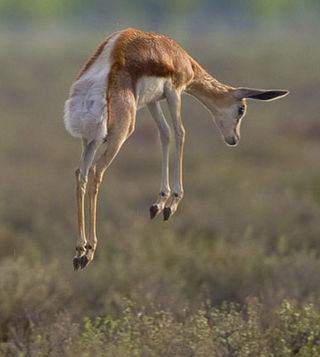Loading AI tools
Jumping display of quadrupeds thought to deter predators From Wikipedia, the free encyclopedia
Stotting (also called pronking or pronging) is a behavior of quadrupeds, particularly gazelles, in which they spring into the air, lifting all four feet off the ground simultaneously. Usually, the legs are held in a relatively stiff position. Many explanations of stotting have been proposed, though for several of them there is little evidence either for or against.

The question of why prey animals stot has been investigated by evolutionary biologists including John Maynard Smith, C. D. Fitzgibbon, and Tim Caro; all of them conclude that the most likely explanation given the available evidence is that it is an honest signal to predators that the stotting animal would be difficult to catch. Such a signal is called "honest" as it is not deceptive in any way, and would benefit both predator and prey: the predator as it avoids a costly and unproductive chase, and the prey as it does not get chased.
Stot is a common Scots and Northern English verb meaning "bounce" or "walk with a bounce".[1] Uses in this sense include stotting a ball off a wall, and rain stotting off a pavement. Pronking comes from the Afrikaans verb pronk-, which means "show off" or "strut", and is a cognate of the English verb "prance".[2]
Stotting occurs in several deer species of North America, including mule deer, pronghorn,[3] and Columbian black-tailed deer, when a predator is particularly threatening,[4] and in a variety of ungulate species from Africa, including Thomson's gazelle and springbok.[5] It is also said to occur in the blackbuck, a species found in India.[6]
Stotting occurs in domesticated livestock such as sheep and goats, typically only in young animals.[7]
Stotting makes a prey animal more visible,[8] and uses up time and energy that could be spent on escaping from the predator. Since it is dangerous, the continued performance of stotting by prey animals must bring some benefit to the animal (or its family group) performing the behavior. Several possible explanations have been proposed,[4][9] namely that stotting may be:
The English evolutionary biologist John Maynard Smith concludes that "the natural explanation is that stotting is an index of condition and of escape capability", used as a signal especially to coursing predators. He also observes that "it is hard to see how it could be a handicap", unless perhaps it is a signal to other gazelles of the same species.[5] C. D. Fitzgibbon agrees that it is most likely an honest signal of condition.[14] Tim Caro comments that there is insufficient evidence "to support or refute a startle effect of stotting, prey signalling its health, the Social Cohesion hypothesis or [an] alarm function of stotting"; in his view, stotting informs a predator that it has been detected.[9]
Seamless Wikipedia browsing. On steroids.
Every time you click a link to Wikipedia, Wiktionary or Wikiquote in your browser's search results, it will show the modern Wikiwand interface.
Wikiwand extension is a five stars, simple, with minimum permission required to keep your browsing private, safe and transparent.